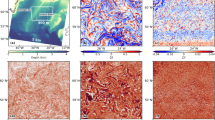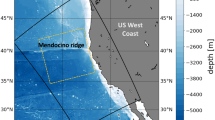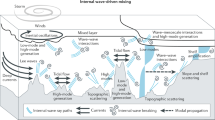Abstract
In the oceans, heat, salt and nutrients are redistributed much more easily within water masses of uniform density than across surfaces separating waters of different densities. But the magnitude and distribution of mixing across density surfaces are also important for the Earth's climate as well as the concentrations of organisms1. Most of this mixing occurs where internal waves break, overturning the density stratification of the ocean and creating patches of turbulence. Predictions of the rate at which internal waves dissipate2,3 were confirmed earlier at mid-latitudes4,5. Here we present observations of temperature and velocity fluctuations in the Pacific and Atlantic oceans between 42° N and 2° S to extend that result to equatorial regions. We find a strong latitude dependence of dissipation in accordance with the predictions3. In our observations, dissipation rates and accompanying mixing across density surfaces near the Equator are less than 10% of those at mid-latitudes for a similar background of internal waves. Reduced mixing close to the Equator will have to be taken into account in numerical simulations of ocean dynamics—for example, in climate change experiments.
This is a preview of subscription content, access via your institution
Access options
Subscribe to this journal
Receive 51 print issues and online access
$199.00 per year
only $3.90 per issue
Buy this article
- Purchase on Springer Link
- Instant access to full article PDF
Prices may be subject to local taxes which are calculated during checkout



Similar content being viewed by others
References
National Science Foundation Ocean Sciences at the New Millennium (NSF, Washington DC, 2001)
McComas, C. H. & Muller, P. The dynamic balance of internal waves. J. Phys. Oceanogr. 11, 970–986 (1981)
Henyey, F. S., Wright, J. & Flatte, S. M. Energy and action flow through the internal wave field: An eikonal approach. J. Geophys. Res. 91, 8487–8495 (1986)
Gregg, M. C. Scaling turbulent dissipation in the thermocline. J. Geophys. Res. 94, 9686–9698 (1989)
Polzin, K., Toole, J. M. & Schmitt, R. W. Finescale parameterization of turbulent dissipation. J. Phys. Oceanogr. 25, 306–328 (1995)
Garrett, C. J. R. & Munk, W. H. Space-time scales of internal waves: A progress report. J. Geophys. Res. 80, 291–297 (1975)
Munk, W. H. in Evolution of Physical Oceanography (eds Warren, B. A. & Wunsch, C.) 264–291 (MIT Press, Cambridge, Massachusetts, 1981)
Sun, H. & Kunze, E. Internal wave-wave interactions. Part II: Spectral energy transfer and turbulence production. J. Phys. Oceanogr. 29, 2905–2919 (1999)
Henyey, H. F. in Dynamics of Internal Gravity Waves in the Ocean: Proceedings, ’Aha Huliko'a Hawaiian Winter Workshop (eds Muller, P. & Henderson, D.) 233–236 (Spec. publ. SOEST, Univ. Hawaii, 1991)
Winkel, D. P., Gregg, M. C. & Sanford, T. B. Resolving oceanic shear and velocity with the Multi-Scale Profiler. J. Atmos. Ocean. Technol. 13, 1046–1072 (1996)
Osborn, T. R. Estimates of the local rate of vertical diffusion from dissipation measurements. J. Phys. Oceanogr. 20, 83–89 (1980)
Davis, R. E. Diapycnal mixing in the ocean: The Osborn-Cox model. J. Phys. Oceanogr. 24, 2560–2576 (1994)
Ledwell, J. R., Watson, A. J. & Law, C. S. Evidence for slow mixing across the pycnocline from an open-ocean tracer release experiment. Nature 364, 701–703 (1993)
Toole, J. M., Polzin, K. L. & Schmitt, R. W. Estimates of diapycnal mixing in the abyssal ocean. Science 264, 1120–1123 (1994)
Ledwell, J. R. et al. Evidence for enhanced mixing over rough topography in the abyssal ocean. Nature 403, 179–182 (2000)
Gregg, M. C. Variations in the intensity of small-scale mixing in the main thermocline. J. Phys. Oceanogr. 7, 436–454 (1977)
Nagasawa, M., Niwa, Y. & Hibiya, T. Spatial and temporal distribution of wind-induced internal wave energy available for deep water mixing in the North Pacific. J. Geophys. Res. 105, 13933–13943 (2000)
Efron, G. & Gong, G. A leisurely look at the bootstrap, the jackknife, and cross-validation. Am. Stat. 37, 36–48 (1983)
Gregg, M. C., Winkel, D. P., Sanford, T. B. & Peters, H. Turbulence produced by internal waves in the oceanic thermocline at mid and low latitudes. Dynam. Atmos. Oceans 24, 1–14 (1996)
Peters, H., Gregg, M. C. & Sanford, T. B. Equatorial and off-equatorial shear variability at 140° W. J. Geophys. Res. 96, 16913–16928 (1991)
Schmitt, R. W., Perkins, H., Boyd, J. D. & Stalcup, M. C. C-SALT: an investigation of the thermohaline staircase in the western tropical North Atlantic. Deep-Sea Res. 34, 1655–1665 (1987)
Gregg, M. C. & Sanford, T. B. Shear and turbulence in thermohaline staircases. Deep-Sea Res. 34, 1689–1696 (1987)
Winkel, D. P., Gregg, M. C. & Sanford, T. B. Patterns of shear and turbulence across the Florida Current. J. Phys. Oceanogr. 32, 3269–3285 (2002)
Gregg, M. C. & Sanford, T. B. The dependence of turbulent dissipation on stratification in a diffusively stable thermocline. J. Geophys. Res. 93, 12381–12392 (1988)
Acknowledgements
The Office of Naval Research and the National Science Foundation funded our instrumentation and data collection. A SECNAV/CNO fellowship in oceanography supported M.C.G. during the analysis and writing of this letter.
Author information
Authors and Affiliations
Corresponding author
Ethics declarations
Competing interests
The authors declare that they have no competing financial interests.
Rights and permissions
About this article
Cite this article
Gregg, M., Sanford, T. & Winkel, D. Reduced mixing from the breaking of internal waves in equatorial waters. Nature 422, 513–515 (2003). https://doi.org/10.1038/nature01507
Received:
Accepted:
Issue Date:
DOI: https://doi.org/10.1038/nature01507
This article is cited by
-
Internal-Wave Convection and Shear Near the Top of a Deep Equatorial Seamount
Pure and Applied Geophysics (2024)
-
Interannual variability of internal tides in the Andaman Sea: an effect of Indian Ocean Dipole
Scientific Reports (2022)
-
Tropical oceanic intraseasonal variabilities associated with central Indian Ocean mode
Climate Dynamics (2022)
-
On equatorial wave–current interactions
Annali di Matematica Pura ed Applicata (1923 -) (2022)
-
A two-stage inflation method in parameter estimation to compensate for constant parameter evolution in Community Earth System Model
Acta Oceanologica Sinica (2022)
Comments
By submitting a comment you agree to abide by our Terms and Community Guidelines. If you find something abusive or that does not comply with our terms or guidelines please flag it as inappropriate.



